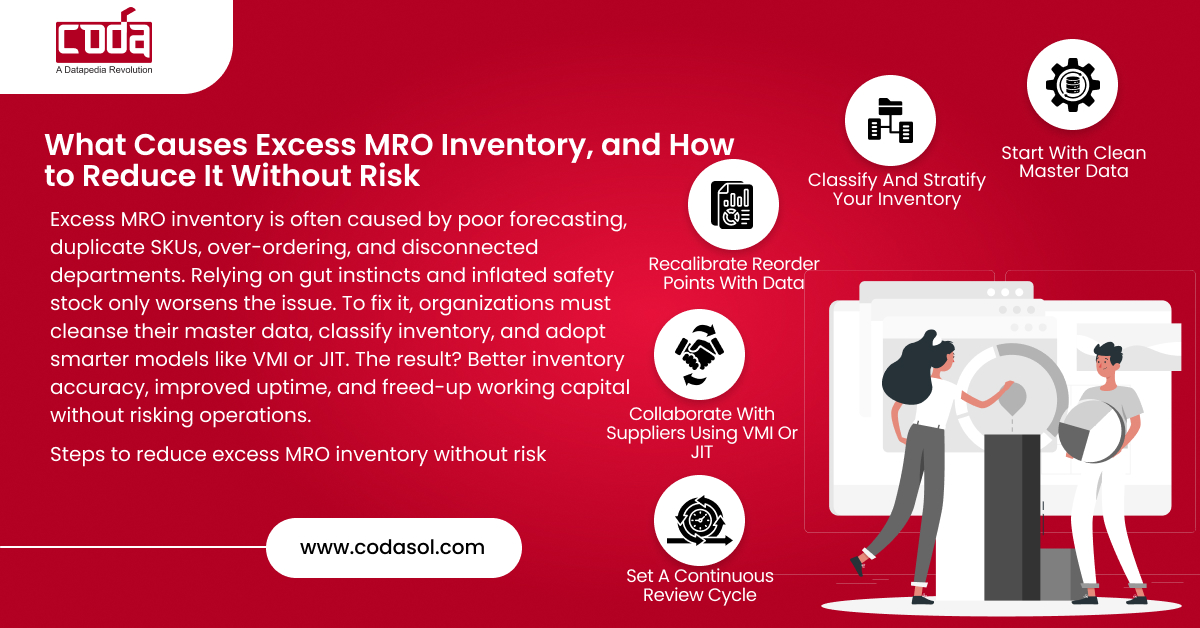Summary: Excess MRO inventory is caused by poor forecasting, duplicate SKUs, data errors, and over-ordering. You can reduce it safely by cleansing your master data, classifying inventory, and using supplier collaboration models like VMI or JIT. Results include freed-up working capital, improved uptime, and better inventory accuracy.
Is your storeroom filled with unused spares that haven’t moved in years, but still getting re-ordered? Excess MRO inventory might seem like a safety net, but it silently drains your working capital, clutters your systems, and delays critical procurement decisions.
In this post, we explore why excess MRO inventory happens and how supply chain and plant managers can reduce it, without risking operational downtime. Whether you’re in Oil & Gas, Utilities, Manufacturing, or EPC, this guide will show you practical, data-backed strategies.
Why Excess MRO Inventory Happens
TL;DR: Most excess comes from reactive ordering, inflated safety stock, poor data, and siloed departments. Fixing data and aligning teams helps reduce it.
- Over-reliance on Gut-Based Forecasting
MRO ordering is often based on outdated trends or internal habits—not analytics. This leads to inflated order volumes. - Excessive Safety Stock
Teams buffer excessively to avoid downtime. This creates stockpiles of rarely used items. - Data Chaos & Duplicates
Without structured material master data, the same item may exist under multiple codes. This leads to overordering. - Long Lead Times
Procurement delays, especially in remote plants, prompt teams to over-order “just in case.” - Disconnected Departments
Lack of communication between maintenance, procurement, and warehousing leads to poor inventory visibility.
How to Reduce Excess MRO Inventory Without Risk
TL;DR: Clean your master data, classify inventory, and adopt modern sourcing models like VMI. Review quarterly and measure with the right KPIs.
1. Start With Clean Master Data
You can’t optimize what you can’t identify. Standardized, enriched, and de-duplicated MRO master data ensures unique, searchable material records. Tools like PROSOL by CODASOL can automate this process.
“Fixing data issues alone can reduce MRO inventory by 10–15%, instantly freeing up working capital.”

Book a 30-minute Discovery Call with our supply chain data experts and see how much inventory you could safely reduce.
2. Classify and Stratify Your Inventory
Use ABC (value-based) and XYZ (consumption variability) analysis:
- AX Items: High-value, high-usage — strict control.
- BZ Items: Medium-value, erratic use — reorder on trends.
- CZ Items: Low-value, rarely used — minimal or no stocking.
This framework, think of it as your Inventory Prioritization Matrix, lets you focus your effort where it matters.
3. Recalibrate Reorder Points with Data
Switch from static to dynamic reorder points by factoring in:
- Seasonality
- MTBF (Mean Time Between Failures)
- Supplier reliability
- Criticality of equipment
This approach typically reduces overstocking by 15–20%.
4. Collaborate With Suppliers Using VMI or JIT
Rather than stocking everything internally, co-manage inventory through:
- VMI (Vendor-Managed Inventory) — ideal for bulk, fast-moving items.
- JIT (Just-in-Time) — for low-cost, high-availability items.
| Model | Best For | Stock Held By | Risk Level |
|---|---|---|---|
| VMI | Medium/High usage spares | Vendor | Low |
| JIT | Low-value, high-access parts | Supplier/3PL | Medium |
| Traditional | All internal MRO items | Buyer | High |
5. Set a Continuous Review Cycle
Quarterly audits help avoid stock build-up. Use metrics like:
- Inventory turnover ratio
- Dead stock percentage
- Stock-out rate
- Service level agreement (SLA) adherence
These provide an early warning system for inefficiencies.
Results You Can Expect
| KPI | Before Optimization | After 6 Months |
| Inventory Value | ₹1.5 Cr | ₹1.0 Cr (↓33%) |
| Inventory Turnover | 3.5× | 6.8× |
| Emergency Stock-Outs (Year) | 8 | 2 |
| Obsolete Items | 12% | <5% |
| Working Capital Reclaimed | – | ₹50–75 Lakhs |
Case Study
A major EPC contractor in the Gulf used CODASOL’s MDM solution alongside ABC/XYZ classification:
- 30,000+ MRO SKUs reviewed
- 18% duplicate reduction
- ₹1.2 Cr of dead stock cleared
- Zero unplanned downtime during the transition
“We always thought holding extra stock was safer, but we were losing money on unused parts. After CODASOL’s implementation, our confidence in ordering decisions has never been higher.” — Supply Chain Head, EPC Contractor
Best Practices by Industry
- Oil & Gas: Align inventory planning with shutdown schedules and criticality risk.
- Utilities: Maintain parts with high MTTR and SLAs.
- Manufacturing: Leverage predictive analytics from IoT sensors.
- Construction & EPC: Link VMI to project schedules to optimize delivery.
FAQs
Q1: What qualifies as MRO inventory?
Items used for Maintenance, Repair, and Operations—not included in finished goods.
Q2: Why is excess MRO stock harmful?
It ties up cash, increases warehouse costs, causes waste, and hides data issues.
Q3: How often should I review MRO inventory?
At least quarterly, and before shutdowns or annual budgeting.
Q4: Can small companies benefit from MRO optimization?
Yes—better data and right-sizing help small plants control costs too.
Q5: How fast is ROI?
Most organizations see results in 3–6 months after implementation.
Conclusion:
Reducing excess MRO inventory doesn’t mean risking downtime. With better data, classification, and smart vendor collaboration, you can unlock capital, improve service levels, and boost procurement agility.
Need help putting this into action?
CODASOL supports supply chain teams across India, the GCC, Far East, and the US with proven MRO inventory optimization frameworks.



